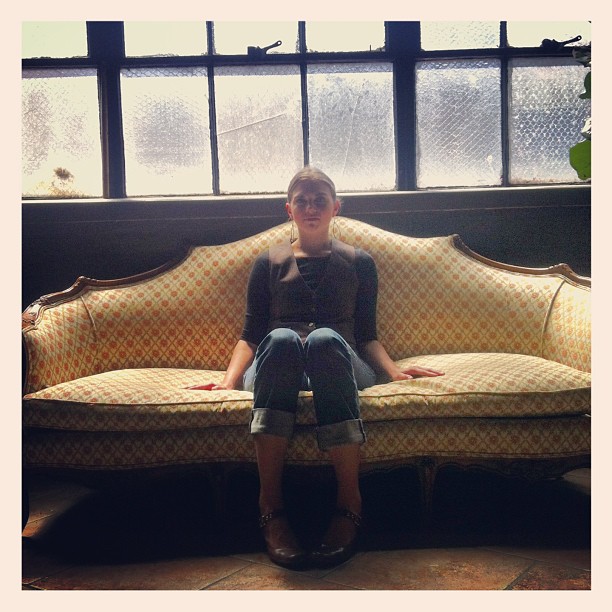Keturah is my mother's step-grandmother. She married Fred after his first wife, Luella, died of pneumonia in 1933. Those who knew Keturah well called her Turah. And though she has intrigued me for as long as I can remember, I have no actual memory of her. I was 4 years old when she died in 1986. All I hold is a faint image of a nursing home and an old woman’s crinkled, smiling face. It could have been any old woman’s face. Yet, as a baker, I crave her recipes. As a writer, I crave her stories.
One summer a few years ago, when I was living in Portland, Oregon, far from my family’s Kansas home, my brother Matt brought me a gift: 2 discs filled to their digital brim with scanned recipe cards of Keturah’s. With a few clicks, I could suddenly behold every detail of Keturah’s feminine, beautifully looping handwriting thousands of miles from her home. I could examine their stains and spills, the scotch tape patching corners together, and the marks made by a pencil or marker or typewriter’s ink. I could answer some of my questions about this woman. How much she loved lemon. How much she baked with lard.
Keturah was a Mennonite woman living in Hesston in 1933. Born in Pennsylvania, she hadn’t stayed still very much, having lived in Ohio, Kansas, Colorado and Alberta, Canada. Then she went back to Hesston, where her time was spent taking care of her sick mother and working for the town’s post office. Her mother, Elizabeth, died on September 4, 1933, four months after Luella. Keturah was available, and Fred was in need of help. So she went to the farm as hired help for his three young children. She stayed on for love, marrying Fred in November 1934. But it just so happened Fred was non-Mennonite. As the story goes, Keturah’s Conservative Mennonite congregation did not tolerate such marriages, and she was cut off from the church.
Each person in my large family who knew her tells their own special story about Keturah, their eyes smiling or sometimes welling up. They are all memories I can never touch.
My mother speaks of Keturah’s long, white hair that she would wash with rainwater and then braid to the side, wrapping it around the crown of her head like an ivory halo.
My grandmother, Joan, tells a story rich with connection as she mutters, “I really miss her.” Joan tells me how everything she knows about the kitchen came from Keturah:
“He [Joan’s husband, my grandfather Alvin] would get up at 4:00 a.m. every morning and go to the family farm to help milk. Many mornings I would get up and go with him. I would sleep on Grandma Keturah’s couch in the living room, wrapped up in her wool throw. When it was time to fix breakfast I would get up and help her. I learned how to make coffee, make eggs and bacon, fry potatoes, and bake cinnamon rolls. The cinnamon rolls were so delicious – they were to die for… Bless Grandma, she patiently showed me step by step how to make them and I really became quite good at it… I was so terribly young and I needed her as a mother figure.”
Each of Keturah’s recipe cards carries the perfume, if just a whiff, of those moments.
Keturah loved to bake. In Kansas at that time, the bakers were given the best tool they could ask for—a nearly perfect grain. Red Turkey hard winter wheat, a variety brought to Kansas by Russian Mennonite migrants dominated the fields and was known for its unique and complex flavor. It began to be gradually replaced in the mid-1940s with higher-yielding wheat. But the heirloom grain is still legendary.
In a short flip through Keturah’s cards, it becomes clear she had a love affair with sugar. Of the 90 total recipes, a shocking majority—71 to be exact—were desserts.
Keturah's favorite dessert: lemon pie.
Of the 71 desserts, there are 7different versions of lemon pie:
Lemon Pie #1
Lemon Pie #2
Lemon Sponge Pie
Lemon Cake Pie—from “Anon,” a smiley face marking the corner
3 different lemon chiffon pies, chiffon spelled differently each time.
Keturah clearly had a substantial circle of women she cooked and baked with. On almost every recipe she gives credit to its maker, noting the source. Every recipe whispers of a friendship, a community, a network of sharing and exchange.
Her lemon pies are credited to Bella, Enola, Anon, Mrs. Elmer Bird, and Velma. And then there’s Floy, Joan, Lillie, Fannie, Mamie, Jessie, Mira, Mrs. Zook. There’s Bertha’s salad, Lulu’s relish, Mrs. Haiber’s fruit cookies, Alma June’s rolls, Enola’s springerli, and Viola’s gnepp.
It strikes me that our current practice of “Email me that recipe” or “Text me those ingredients” would seem so absurd to Keturah. Gathering a recipe from a friend was an opportunity for face-to-face interaction—at the kitchen table, coffee cup in one hand, pencil in the other, listening to Lillie about how to get that lemon chiffon just right.
I try not to pretend that I know Keturah merely because I hold these cards. Her life of migration, grief, a lost church, and the work of a dairy farm is not written out on the back of her biscuit card. But I do know Keturah loved lemon. Keturah gave credit where credit was due. Knowing those details somehow satisfies my intrigue a bit—with one swoop of her looped cursive L for Lemon.




